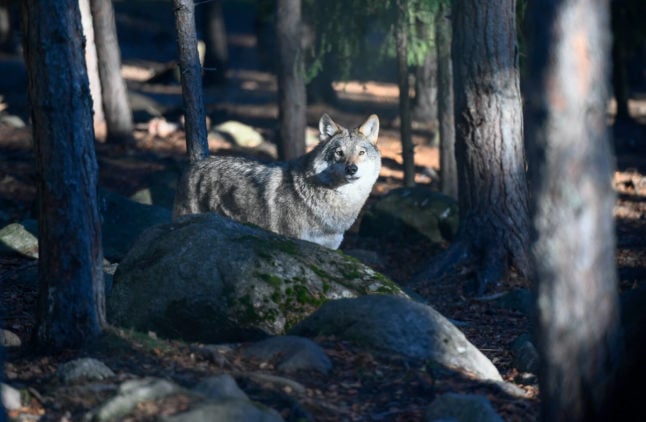Johan Larsson and his dog, Zero, were out hunting in a forest near Hässleholm, Southern Sweden, in October when they were attacked by a boar. The animal drove its tusk into the back of Larsson’s thigh, leaving a deep gash that just missed his femoral artery.
“I had protective trousers on, but when this animal attacks it uses its tusks in an upward, jabbing motion, and unfortunately there was no protection at the back of my thighs,” Larsson says.
It is not the first time he and his dog have been attacked. Earlier this year a boar ripped Zero’s hind leg open, an injury that was nearly fatal.

“There is a calculated risk you must take when hunting boar – that both you and the dogs can get hurt. This is a dangerous wild animal, the most dangerous we have in Sweden,” Larsson says.
Earlier this month, a boar rampaged through a McDonald’s restaurant in Uppsala. In the summer, a hunter in southern Sweden died after a boar gored his inner thigh – the country’s first such fatality. The last wolf attack on humans took place in 1821.
“The danger of attack by a wild boar is much greater than the wolf,” explained Jens Frank, from Sweden’s University of Agricultural Sciences in Uppsala. “We have several hundred thousand boar, and only a few hundred wolves, so of course there is a greater risk of getting hurt or killed.”
Wild boar were extinct in Sweden until a few decades ago. However, following escapes from captivity in the 1980s, the population has exploded and spread rapidly across the country – currently estimated at 300,000 – compared to a wolf population of 460. That’s a ratio of 600 boars for each wolf – and it’s growing by 15% annually.
Boars have caused more than 5,100 traffic accidents in 2022, compared to just ten caused by wolves. Their rooting behaviour destroyed an estimated 84,500 tons of crops in 2020, causing losses of 1.1 billion kronor (€100 million) and creating a serious problem for farmers.
It is the wolf, however, that has become the focus of concern in Swedish society. In May, the government announced it would cull the wolf population by as much as half, in a move that could breach EU conservation directives.
The number of licenses to hunt wolves issued by local authorities has quadrupled compared to last year, according to Sweden’s Environmental Protection Agency (EPA). This suggests that around 100 wolves will be shot when the season starts on January 2nd – by far the largest cull in modern times. The government is also calling on the EU to remove the wolf from the list of species requiring protection.
The wolf occupies a special place in Swedish folklore, evoking deep-seated fears and irrational hatred, according to Hanna Dittrich-Söderman, who leads the EPA’s work on wolves.
“There is no other animal that is so easy to both demonise and glorify as the wolf – an imagined fear or hatred has been attached to it,” she says. “We have almost made it a symbol of our fearful nature as a whole, it has almost mythical qualities.”

Wolves are also considered a threat to dogs, Dittrich-Söderman points out, in a country where “the dog is seen as part of the family”. Parliamentary debates on the wolf have frequently cited a danger not only to humans but also to pets. Swedes are entitled to compensation from the state of up to 25,000 kronor (€2,300) for an uninsured dog killed by a wolf.
Yet, boars injure several hundred dogs each year, while only a handful are injured by wolves. Between 2018 and 2021, far more dogs were accidentally killed or injured by boars than by wolves, according to statistics collected by animal insurers Agria, who insure around 40 percent of dogs in Sweden.
In fact, not counting traffic accidents, wild boars were by far the major culprits behind dog injuries during the four-year period, causing more deaths, losses or injuries than all other categories combined.
In addition to this, Agria states that figures for injuries caused by wild boars could be much higher than that for those caused by other animals, as many injuries caused by boars are reported to the insurance company by veterinarians as just “wounds” or “bite wounds”, or as injuries by an unspecified wild animal, which falls under the category “killed/injured by other wild animal”.
Many people aren’t aware of the danger the large boar population can pose to walkers and dog owners in Sweden.
“You’re out walking in the woods, the dog runs away and comes back with a wild boar hot on its heels,” said Magnus Jonström, a hunter based in Strömstad, south-west Sweden. “This is how you, or your dog, might get attacked”.
Wolves do, however, pose a threat to livestock, with wolves killing 286 sheep last year, according to the Wildlife Damage Centre at the Swedish University of Agricultural Sciences. Sweden’s total sheep population is estimated at around half a million. Despite this, between 2011 and 2019, lynx or bobcats caused more injuries to Sweden’s sheep and goat populations than wolves.
“Sweden has one of the best incentive programs to encourage farmers to protect their sheep by putting up electric fences – which are effective against wolves,” Jens Frank said.
However, the government only compensates farmers after a fence has been built, and most farmers cannot afford to pay upfront, he added. Moreover, the price of electricity has soared in Sweden, meaning the cost of running the fences has skyrocketed.
The Swedish Hunters Association acknowledges the problems caused by boar but says wolves must be culled because of the strong feelings they evoke in rural communities.
“Even if they have done no harm, the wolf creates fear and unease, and that must be taken into account,” says the Association’s Magnus Rydholm. “There are people who are afraid of the dark when they know logically that there is no danger, but fear is not rational.”
“You have to acknowledge how people think and feel – that also applies to tigers in India and lions in Africa.”
So, should you be worried if you spot a wolf in the wild? Not really, hunter Magnus Jonström believes.
“It would be extremely rare to actually see one, and most likely it would just run away,” he explained.
“Wolves are very shy animals.”
By Beata Furstenberg, additional reporting by Jakob Ranglin Grissler and Matteo Scannavini.





 Please whitelist us to continue reading.
Please whitelist us to continue reading.
Thanks for this article Beata, Jakob, and Matteo.
I live in a part of the country where the beginning of the älg (moose) hunting season, seemingly has almost every local human male, slavering.
This year they’re agog anew due to the upcoming wolf hunt, in addition to which, they’ve somehow been granted a hunt of lynx, that most beautiful, and elusive forest creature.
‘Tis a crying shame.
As a lifelong vegan I don’t condone any hunting, however at least wild boar can be eaten. Both wolf and lynx are only hunted for sport.